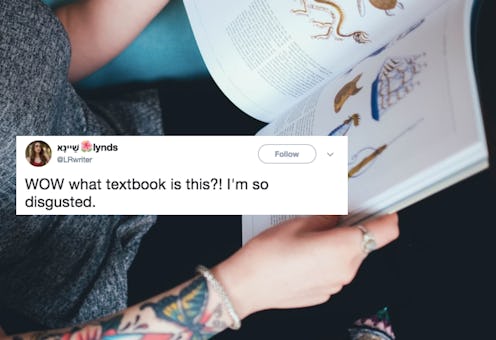Life
Twitter Is Pissed At This Nursing Textbook That Perpetuated Racist Stereotypes
Another day, another racist blunder in academia. Over the past few years, colleges and universities have come under fire because both campuses and educational resources alike are having trouble including people of color in their curricula. Recently, a nursing textbook has sparking outrage among people and students online. The textbook, “Nursing: A Concept-Based Approach to Learning, Volume I,” published by Pearson Education, featured a section that depicted harmful stereotypes about minorities' responses to pain, which people on Twitter were quick to react to.
The textbook, which was published in 2015, features a section called “Focus on Diversity: Cultural Differences in Response to Pain,” that harmfully and incorrectly stereotypes different minority groups. For example, the textbook suggests, “Hispanics may believe that pain is a form of punishment and suffering must be endured if they are to enter heaven.” It also says that Native Americans may prefer to take medicine that was “blessed by a tribal shaman,” and Asian people who “complain openly about pain [are] thought to have poor social skills.”
A representative for Pearson Education tells Bustle via email:
While differences in cultural attitudes towards pain is an important topic in medical programs, the table from this Nursing text did not present the information in an appropriate manner. We apologize for the offense this has caused, and we have removed the material in question from current electronic versions and future editions of this text. We always welcome feedback, and we appreciate the concern shown by the students who raised this issue.
The textbook’s page was originally shared on Twitter, by a user with the handle @LRwriter, who captioned the photo saying, “WOW what textbook is this?! I'm so disgusted.” In the responses, @LRwriter added, “Yes, my Jewish ass is demanding of assistance when I'm in the hospital,” in response to the textbook’s generalization that Jewish people “may be vocal and demanding” when in pain.
Some folks on Twitter expressed their anger toward the textbook, with one user saying, “This is disgusting! In the 21st century, what country would allow such bias and absurd incorrect stereotyping?” Another Twitter user said, “Everything about this, everything, pisses me off, but [the comments] had me laughing, so thank you.”
Not only did Twitter users point out the textbook’s racist stereotyping and language, but many also criticized the book’s apparent lack of understanding that race and ethnicity are not the same thing. “So what if you're Black and Jewish? Or white passing Hispanic? Like this is just impressively stupid on top of the racism,” said Twitter user Beck Frydenborg, adding, “It's like a 4-year-old tried to classify people with the help of their racist uncle.” Additionally, some people pointed out that while the textbook listed “Blacks,” “Hispanics,” and other minority groups, it didn't list a section for white people. One Twitter user said “If you want to talk about cultural variation in response to pain, surely they should also include ‘whites.’ With dismissive language.”
Though the justified outrage of Pearson Education’s textbook began on Twitter, many people took to Amazon — which sells a hard copy and Kindle version of the book — to leave reviews and comments. One reviewer, Judy S. Davis, left the textbook a one-star rating and wrote, “I'm absolutely horrified by the racism and outright lies in the ‘Focus on Diversity: Cultural Differences in Response to Pain’ section...You have printed all these generalizations and assumptions as though they are facts. They are not. They are offensive and racist.” Another Amazon customer left an anonymous review, stating, “Page 161 alone disqualifies this textbook as being entirely evidence-based. If this kind of racist dreck can pass unnoticed by the authors AND editors of this book, it cannot be trusted.” Since the OG tweet about Pearson Education’s textbook was posted on Oct. 17, the book has received at least nine single-star ratings because of the racist content.
Studies as recent as 2016 have shown racial bias in medicine is all too real, and causes people of color to receive substandard treatment and care. Perpetuating stereotypes about minorities, especially in materials designed to educate caregivers, feeds into this racial bias and makes it all the more difficult for minorities to receive the standard of care they deserve. Higher education has a responsibility to educate future medical professionals, without playing into racist stereotypes that hurt marginalized communities. Medical care should always be inclusive and equitable, period.
